Artemis (Diana)
Artemis a Greek Goddess of the Hunt, Forests and Hills, the Moon, Archery.
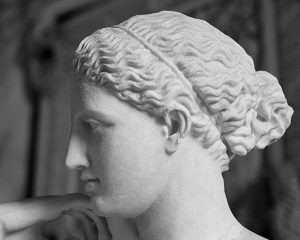
Who is Artemis?
Artemis was the Greek goddess of pristine nature, vegetation hunting and chastity in Greek religion. Artemis was the daughter of Zeus and Leto, and twin sister of Apollo. It was believed that Leto, after conceiving from Zeus, gave birth to her twins on the island of Delos. She was the aide women during childbirth, and the patron of animals. She stroll through the wilderness with arrows over her shoulder. She was worshipped across the Greek world, but her most famous cult site was as a fertility goddess at the Temple of Artemis at Ephesus, one of the Seven Wonders of the Ancient World. To the Romans, the goddess was known as Diana. Dances of maidens representing tree nymphs (dryads) were especially common in Artemis’ worship as goddess of the tree cult, a role especially popular in the Peloponnese.
According to one source, Artemis was born a day before Apollo. She then served as a guardian to him, which provided a context for her desire to protect and nurture.
Names and Epiteths
Artemis was called by many different epithets. Like her brother Apollo who represented the sun, Artemis represented the moon. She was called ‘Agrotera’ the huntress goddess. She was also known as ‘Potnia Theron’, the goddess of wild animals. Homer calls Artemis either “The Mistress of Animals” or “She of the Wild.”
She guarded her virginity carefully. Actaeon and Orion tried to dishonor or rape her, but anyone who threatened her purity met with a violent end
In Mythology
The worship of Artemis probably flourished in Crete or on the Greek mainland in pre-Hellenic times. As beautiful and good natured as she was, her anger was
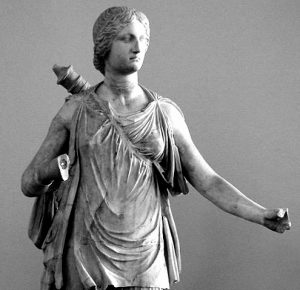
rampant. For instance, because King Admetos forgot to present offering to her, she filled his nuptial chamber with snakes. She was angered by Meleager’s father Oeneus and sent a boar to his land and made it eat the whole field. No mortal was able to touch Artemis, nor were they able to see her naked. Those who saw her naked, like Actaeon, suffered their punishment. Acteon, who was raised by a centaur and was a good hunter like Artemis, claimed that he was actually better at hunting than she was. One day, Artemis and her nymphs went to a forest to cool off in the lake. Convinced that nobody would see them in this hidden corner, they all took their clothes off, immersed into the lake and began dancing. Before long, Actaeon heard their voices and went near them with his bow and arrow. Shrieking, the nymphs surrouded Artemis to hide the goddes from his eyes. At this moment, Artemis came out of the lake and approached this young man. She feared that he would tell everyone that he saw her and her nymphs naked. Therefore, she splashed some lake water on the face of this young man. At that moment, horns began to grow on the head of Actaeon, and he transformed into a stag. The hounds that were devoured Actaeon right on the spot, in an excitement to find a prey. This is how Artemis brutally punished Actaeon for seeing her naked and claiming that he was better hunter than her.
As maidens, girls would pray to Artemis, and in return , she would help them after marriage, during their chilbirth. Artemis was the same time goddess of womanhood. She has also symbolized the earth and fertility. Many of Artemis’ local cults, however, preserved traces of other deities, often with Greek names, suggesting that, upon adopting her, the Greeks identified Artemis with nature divinities of their own. The virginal sister of Apollo is very different from the many-breasted Artemis of Ephesus
Artemis plays only a minor role in the Trojan War of Homer’s Iliad and is described most often as ‘the archer goddess’ but also on occasion as the ‘goddess of the loud hunt’ and ‘of the wild, mistress of wild creatures’. Supporting the Trojans, she notably heals Aeneas after he is wounded by Diomedes.
Artemis and Hippolytus
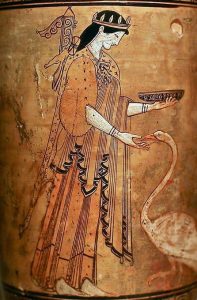
She punished the transgressors of the sacred vow, Artemis rewarded those who kept it. Hippolytus scorned Aphrodite after which the goddess of love made his stepmother fall in love with him. This set a chain of events which led to Hippolytus’ death. However, Artemis called upon Asclepius and resurrected Hippolytus as a new man, who subsequently ruled in Italy under the name of Virbius.
Artemis and Iphigenia
At the start of the Trojan War which involves the goddess is the saving of Iphigenia, daughter of Agamemnon. The king had displeased the goddess by killing one of her sacred deer. As punishment, Artemis becalmed the Archaean fleet and only the sacrifice of Iphigenia would appease the goddess into granting a fair wind to Troy. Afterward, she took Iphigenia with her in Tauris and made her a priestess of her cult.
Artemis and Callisto
After her hunting attendant Callisto gave birth to Zeus’s son Arcas, Artemis contrived with Hera to turn her into a bear. owever, just as that was about to happen, Zeus placed both of them into the heavens as the constellations Ursa Major and Ursa Minor.
Artemis was worshipped widely in Greece but only as a secondary deity.
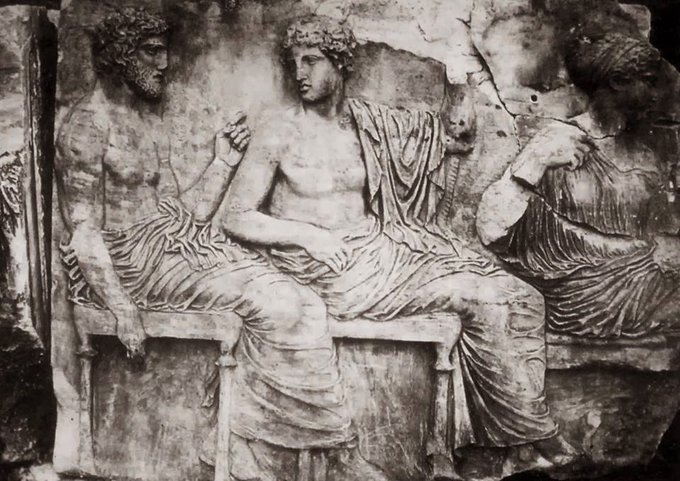
Temple of Artemis at Ephesus
Homer refers to Orytygia as the birthplace of Artemis. The people of Ephesus recorded that Ortyygia was the name given to the woods near Ephesus, during times of Tiberius. So, this goddess with complete Anatolian characteristics must have been related to Ephesus too.
The three-storey temple on three head of Artemis indicates that she is the guardian of cities as well as the wilderness. The crescent on her forehead symbolizes her virginity and that she is the goddess of the moon. Her multipe breasts are in reference to her being a goddess of fertility.
A temple built in her honor became one of the “Seven Wonders of the Ancient World
She was worsipped by the Romans mainly as Diana the goddess of moon and light. During the festival of Artemis held in the town of Caryae lying in the vicinity of
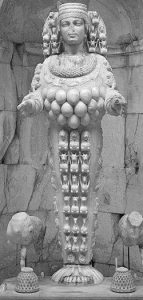
Sparta, maidens danced wearing basket-like wreaths made from reeds. Sculpted females that funciton as columns in arcitecture were named adter this theme as Caryatid. Diana of Versailles, showing her with a quiver over her shoulder and a stag near her, is the most statue of her. A Roman copy of this 4th century-BC work is found at the Louvre Museum today. Also in this museum is a Roman copy of the Artemis of Gabii which is known to have been created by Praxiteles. Artemis of Ariccia, found at the Therme Museum in Rome is a copy of a sculpture dating to the 5th century. Artemis is mostly described in her scupltures with quiver on her shoulder and a stag near her. In some of these depictions, Artemis holds a shining crescent in her hand, and in some of them she is seen with a wreath of stars around ger head. Sometimes this young and beautiful goddess is illustrated in her statues wearing a short garment revealing her bodilyparts, nad sometims, holding a torch that symbolizes the moon. Animals that were offered to her were stags, hounds, roosters, patridges, bears, pigs and wolves. Laurel, mytrle, cypress and olive trees were the favourites of the beautiful goddess. To honor their goddess, the people of Ephesus built the Temple of Artemis which was one of the Seven Wonders of the World. This building was built over the holy site of Cybele, the mother goddess of Anatolia, and measured 190 m. İn lenght and 55 m. İn widht. It was the first marble structure made in the Ionic order. The temple with 127 columns had 36 of its columns decorated with embossments. One of these was created by the famed sculptor Scopas. The altar in front of the temple was the work of Praxiteles. The culptures of the monument of Amazons, which wa inside, were created by the famous artists of Antiquity such as Polycleitus, Phidias, Kresilas and Kydon. The paintings at the temple were creatings of Apelles of Ephesus. The first altar in this location, belonging to Artemis,w a buit in 625 BC, however, it was demolished during the attack of Cimmerians. The Temple of Artemis- one of the seven wonders in the World- was built on this site around 564-546 BC. King Croesus of Lydia also assisted in the construction of it. The embossed column base which is at the British Museum today was a gift from him. Unfortunately, a crazy person named Herostratus set fire to this temple in 356 BC, on the night when Alexander the Great was born. During his campaign to Asia, Alexander the Great discovered that this temple was burnt on the night when he was born and wanted to contribute to its reconstruction, but the people of Ephesus returned his offer and rebuilt the Temple of Artemis themselves. Unfortunately, this building was pillaged during Christianity and its Stones were used in the constructions of Hagia Sophia and Church of St. Jean in Ephesus.
Other Places of Worship
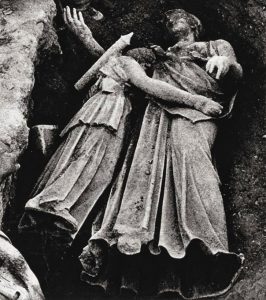
There are many other temples honoring Artemis in Anatolia. The Temple of Artemis that is located in Sardis the capital of Lydia was built in three different stages. The first temple was built around 300 BC, the second stage was 175-150 BC, and the third stage coressponds to AD 150. Two columns remain standing from this temple today. The temples of Artemis in Side and Letoon are near those of her brother Apollo. The temples in Letoon describe Artemis with her quiver and arrows, and Apollo with his lyre. Artemis was worshipped in Perge as ‘Pergaia’ meaning the Artemis of Perge. A temple of Artemis exists in Magnesia near Söke of the Aegean Region, built by Hermogenes -one of the greates architects of his time- during the third quarter of the 2nd century BC. This temple measuring 41 x 67 m. was one of the foremost buildings of its time and had 8 x 15 columns and was ascended by 9 stairs. The frieze on the four sides of the temple, measuring 175 cm. in height, illustrates the war between the Greeks and Amazons in the form of an embossment. The embossments of this temple, which is in ruins today, are at the Istanbul Archaeology Museums. Artemis was later associated with Hecate and Selene.

